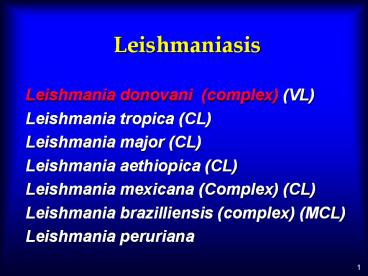Leishmaniasis - PowerPoint PPT Presentation
1 / 32
Title:
Leishmaniasis
Description:
Leishmania donovani (complex) (VL) Leishmania tropica (CL) Leishmania major (CL) Leishmania aethiopica (CL) Leishmania mexicana (Complex) (CL) Leishmania ... – PowerPoint PPT presentation
Number of Views:874
Avg rating:3.0/5.0
Title: Leishmaniasis
1
Leishmaniasis
- Leishmania donovani (complex) (VL)
- Leishmania tropica (CL)
- Leishmania major (CL)
- Leishmania aethiopica (CL)
- Leishmania mexicana (Complex) (CL)
- Leishmania brazilliensis (complex) (MCL)
- Leishmania peruriana
2
The Parasite
- Phylum
- Order
- Family
- Genus
- Sarcomastigophora
- Kinetoplastida
- Trypanosomatidae
- Leishmania
3
Morphology
Digenetic Life Cycle
- Promasitogte
- Insect
- Motile
- Midgut
- Amastigote
- Mammalian stage
- Non-motile
- Intracellular
4
Morphology
- Promastigote
- Amastigote
Flagella Kinetoplast Golgi Nucleus Cytoskeleto
n
5
Promastigote
6
- Amastigotes () of Leishmania donovani in the
cells of a spleen. The individual amastigotes
measure approximately 1 µm in diameter.
7
Amastigote
8
- Amastigotes of Leishmania in a macrophage from a
lymph node of a dog.
9
- Leishmania (Leishman-Donovan or LD bodies). Lying
in macrophage cells from liver. Giemsa. 12000.
Enlarged by 9.6.
10
- A macrophage filled with Leishmania amastigotes.
11
Life cycle
- The organism is transmitted by the bite of
several species of blood-feeding sand flies
(Phlebotomus) which carries the promastigote in
the anterior gut and pharynx. It gains access to
mononuclear phagocytes where it transform into
amastogotes and divides until the infected cell
ruptures. The released organisms infect other
cells. The sandfly acquires the organisms during
the blood meal, the amastigotes transform into
flagellate promastigotes and multiply in the gut
until the anterior gut and pharynx are packed.
Dogs and rodents are common reservoirs.
12
(No Transcript)
13
Mammalian Hosts
- Rodents
- Gerbils
- Hyraxes
- Bats
- Porcupines
- Opossums
- Sloths
- Primates
- Dogs
- Foxes
- Anteaters
- . . . . .
14
Vectors
- Phlebotomine Sandflies
- 6 genera world wide distribution
- Phlebotomus Lutzomia
- 500 species
- Females Haematophagus
- Males sap feeders
15
(No Transcript)
16
Clinical Disease
- Visceral
- Fatal (90 untreated)
- Liver
- Spleen
- Bone marrow
- Cutaneous
- Generally Self- healing
- Skin
- Mucous membranes
SPECTRUM OF DISEASE
17
Initial Infection
- Similar in all species
- Inoculation of promastigotes
- Inflammation chemotaxis
- Receptor mediated phagocytosis
Promastigote
Amasitgote Transformation
18
Parasite Spread
- Macrophage lysis parasite release
- Lymphatic spread
- Blood spread
- Target organs
- Skin/lymph nodes/spleen/liver/
- bone marrow
19
Visceral Leishmaniasis
- 1903
- 1920
- 1931
- William Leishman
- Pentavalent antimony
- Experimental transmission
Leishmania donovani (Complex) L.d. archibaldi -
L.d.chagasi - L.d.donovani - Ld.infantum
20
VL - Clinical Manifestation
- Variable - Incubation 3-100 weeks
- Lowgrade fever
- Hepato-splenomegaly
- Bone marrow hyperplasia
- Anemia, Leucopenia Cachexia
- Hypergammaglobulinnemia
- Epistaxis , Proteinuria, Hematuria
21
- Profile view of a teenage boy suffering from
visceral leishmaniasis. The boy exhibits
splenomegaly, distended abdomen and severe muscle
wasting.
22
- A 12-year-old boy suffering from visceral
leishmaniasis. The boy exhibits splenomegaly and
severe muscle wasting.
23
- Jaundiced hands of a visceral leishmaniasis
patient.
24
- Enlarged spleen and liver in an autopsy of an
infant dying of visceral leishmaniasis.
25
Post Kala Azar Dermal Leishmanoid
- Normally develops lt2 years after recovery
- Recrudescence
- Restricted to skin
- Rare but varies geographically
26
Cutaneous leishmaniasis of the face.
27
A cutaneous leishmaniasis lesion on the arm.
28
INFECTION
- Sub-clinical or inapparent infection
Recovery
Death Immune to reinfection
Concurrent infection PKDL
29
Diagnosis
- Clinical signs symptoms
- Hypergammaglobulinemia
- ELISA/Formol gel
- Bone marrow biopsy
- Spleen or liver biopsy
- Culture Histology
30
Speciation
- Similar morphology
- Isoenzyme profiles - Zymodemes
- Monoclonal antibodies
- DNA hybridisation - PCR
31
Treatment
- Good nursing
- Diet
- Antibiotics
- Pentavalent antimony
- Pentamidine
- New drugs - New delivery
32
Control
- Vector control
- Reservoir control
- Treatment of active cases
- Vaccination































